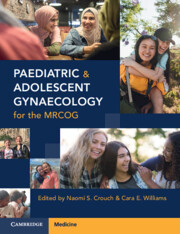Book contents
- Paediatric and Adolescent Gynaecology for the MRCOG
- Paediatric and Adolescent Gynaecology for the MRCOG
- Copyright page
- Contents
- Contributors
- Introduction
- Chapter 1 Embryological Development of the Internal and External Female Genitalia
- Chapter 2 Gynaecological History and Examination in Children and Adolescents
- Chapter 3 Normal and Precocious Puberty
- Chapter 4 Common Prepubertal Problems in Paediatric Gynaecology
- Chapter 5 Adolescent Menstrual Dysfunction
- Chapter 6 Polycystic Ovary Syndrome in Adolescence
- Chapter 7 Müllerian Duct Anomalies
- Chapter 8 Primary Amenorrhoea and Delayed Puberty
- Chapter 9 Rokitansky Syndrome
- Chapter 10 Turner Syndrome
- Chapter 11 Differences in Sex Development
- Chapter 12 Premature Ovarian Insufficiency
- Chapter 13 Gynaecological Laparoscopy in Adolescents
- Chapter 14 Psychology in Paediatric and Adolescent Gynaecology
- Chapter 15 Legal and Ethical Aspects of Paediatric and Adolescent Gynaecology
- Index
- References
Chapter 1 - Embryological Development of the Internal and External Female Genitalia
Published online by Cambridge University Press: 28 January 2023
- Paediatric and Adolescent Gynaecology for the MRCOG
- Paediatric and Adolescent Gynaecology for the MRCOG
- Copyright page
- Contents
- Contributors
- Introduction
- Chapter 1 Embryological Development of the Internal and External Female Genitalia
- Chapter 2 Gynaecological History and Examination in Children and Adolescents
- Chapter 3 Normal and Precocious Puberty
- Chapter 4 Common Prepubertal Problems in Paediatric Gynaecology
- Chapter 5 Adolescent Menstrual Dysfunction
- Chapter 6 Polycystic Ovary Syndrome in Adolescence
- Chapter 7 Müllerian Duct Anomalies
- Chapter 8 Primary Amenorrhoea and Delayed Puberty
- Chapter 9 Rokitansky Syndrome
- Chapter 10 Turner Syndrome
- Chapter 11 Differences in Sex Development
- Chapter 12 Premature Ovarian Insufficiency
- Chapter 13 Gynaecological Laparoscopy in Adolescents
- Chapter 14 Psychology in Paediatric and Adolescent Gynaecology
- Chapter 15 Legal and Ethical Aspects of Paediatric and Adolescent Gynaecology
- Index
- References
Summary
The development of internal and external genitalia starts from the same baseline embryological point. From the ninth week of gestation, it diverges to differentiate into either male or female, depending on chromosomes, genes and hormones. The development of internal female genitalia is closely linked to that of the urinary tract; hence relevant details of urinary tract embryology will be outlined in this chapter.
- Type
- Chapter
- Information
- Publisher: Cambridge University PressPrint publication year: 2023



